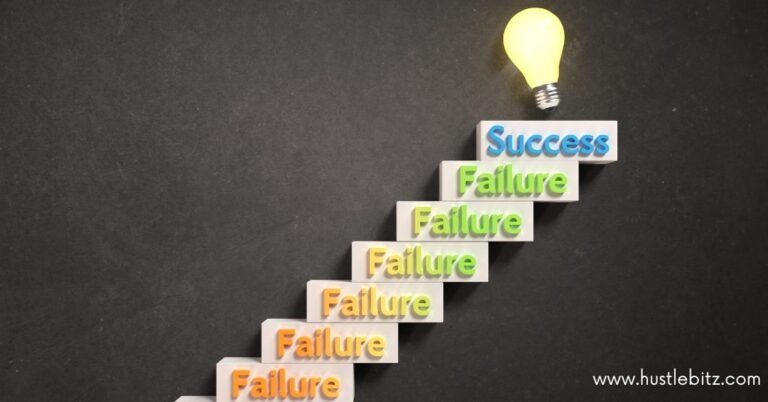Motivation through failure is a transformative process where setbacks serve as meaningful lessons. Embracing failure fosters resilience, allowing individuals to grow stronger in the face of adversity. Shifting one’s mindset to view challenges as opportunities promotes personal development and encourages positive self-talk. Utilizing strategies like reflective journaling and feedback can enhance learning from past mistakes. Establishing new goals and refining approaches after setbacks ensures ongoing growth. This journey emphasizes the importance of resilience and adaptability in pursuing success. Discover the key strategies that can further unlock your potential and enhance your ability to thrive in the face of challenges.
Key Takeaways
- Embrace failure as a valuable teacher, offering insights that drive personal growth and resilience.
- Reframe setbacks as opportunities for learning, fostering a growth-oriented mindset.
- Develop emotional resilience through mindfulness and self-care practices to navigate challenges effectively.
- Set new goals based on lessons learned, ensuring alignment with personal values and passions.
- Utilize reflection and feedback to continuously improve and adapt strategies for future success.

Understanding the Value of Failure
Failure serves as a critical teacher, offering invaluable lessons that foster personal growth and resilience. Understanding the multifaceted nature of failure is essential, as it encompasses various definitions and interpretations that differ across cultural perceptions.
In many societies, the fear of failure can be paralyzing, preventing individuals from embracing discomfort and taking risks. However, reframing failure as an opportunity for growth can transform failure narratives into powerful examples of success.
The psychological impact of failure is profound; it often challenges one’s self-esteem and motivation. Yet, within learning environments that encourage experimentation and the acceptance of mistakes, individuals can develop the skills necessary for overcoming obstacles.
For instance, entrepreneurs frequently cite failure examples as pivotal moments that led to their ultimate success, highlighting how setbacks can serve as stepping stones rather than stumbling blocks.
Resilience and Triumph

Resilience emerges as a fundamental trait that enables individuals to navigate challenges and ultimately achieve triumph in their personal and professional lives. It is through overcoming obstacles that resilience is cultivated, allowing individuals to bounce back from setbacks and emerge stronger. This process is not merely about enduring hardships; it is about building strength and enhancing grit in the face of adversity.
Cultivating perseverance is essential in this journey. Those who foster tenacity are better equipped to embrace discomfort, viewing it as an opportunity for growth rather than a deterrent. By developing coping strategies, individuals can effectively manage stress and uncertainty, thereby nurturing self-belief and reinforcing their capacity to overcome future challenges. This belief in oneself is crucial for achieving personal growth, as it propels individuals to take risks and pursue their aspirations despite the likelihood of failure.
Moreover, resilience is not a static characteristic but a dynamic skill that can be strengthened over time. Engaging in activities that challenge one’s limits can significantly enhance resilience, providing a framework for learning from failures and setbacks. As individuals experience and overcome difficulties, they develop a deeper understanding of their capabilities and potential.
Shifting Your Mindset

Embracing a growth-oriented mindset is essential for transforming setbacks into valuable learning experiences. Mindset shifts enable individuals to view challenges not as insurmountable obstacles but as opportunities for growth and development. By redefining success to include learning and resilience, we can overcome negativity that often accompanies failure. This shift encourages us to embrace uncertainty, recognizing that it is a natural part of the journey toward achieving our goals.
Engaging in positive affirmations can further support this transformation. By affirming our capabilities and potential, we cultivate patience and foster adaptability, allowing us to navigate the complexities of setbacks with grace. Visualizing growth helps us see the potential outcomes of our efforts, encouraging us to persist despite challenges. This practice nurtures creativity, enabling innovative solutions to emerge from difficult situations.
Moreover, developing optimism in the face of adversity empowers us to remain focused on possibilities rather than limitations. By fostering a mindset that sees failure as a stepping stone, we can cultivate resilience and enhance our capacity for growth.
Ultimately, shifting our mindset requires commitment and intentionality, but the rewards are profound. As we learn to embrace setbacks with curiosity and openness, we unlock new paths to success and reaffirm our belief in our ability to thrive. This mindset not only benefits our professional pursuits but enriches our personal lives, leading to a more fulfilling existence.
Identifying Lessons in Setbacks

Recognizing the valuable lessons embedded within setbacks is a critical skill that can significantly enhance personal and professional growth. By engaging in lesson recognition, individuals can transform failures into opportunities for improvement. The process involves several key strategies that facilitate understanding and progress through failure analysis and error assessment.
- Obstacle Identification: Begin by pinpointing specific challenges faced during the setback. This clarity allows for targeted reflection on what went wrong and why.
- Reflective Journaling: Document your thoughts and feelings surrounding the setback. This practice encourages deeper experience evaluation and helps in articulating insights that might otherwise remain unexamined.
- Feedback Incorporation: Seek constructive criticism from peers or mentors. Incorporating feedback enhances learning strategies and provides alternative perspectives that may reveal overlooked lessons.
- Mindset Adjustment: Use the insights gained from the previous steps to adjust your mindset. Embrace a proactive approach to future challenges, understanding that each setback is a stepping stone toward success.
Through these methods, individuals can cultivate a more resilient attitude, enabling personal growth and development. By systematically addressing setbacks, one can foster a culture of continuous improvement, paving the way for future successes.
This approach not only aids in overcoming immediate obstacles but also equips individuals with the tools necessary for navigating future challenges effectively. Embracing the lessons hidden within failures ultimately leads to a richer, more nuanced understanding of both oneself and the journey toward achieving goals.
Embracing a Growth Mentality
A growth mentality fosters an environment where individuals view challenges and failures as essential components of their personal and professional development.
Embracing a growth mindset encourages individuals to see setbacks not as indicators of inadequacy but as learning opportunities that can propel them forward. By actively engaging in adaptive thinking, people can reframe their perspectives on obstacles, transforming fear into motivation for continuous improvement.
Resilience training plays a crucial role in this process, equipping individuals with the tools to overcome fear and uncertainty. It emphasizes the importance of positive self-talk, which can significantly alter one’s response to challenges. By cultivating an internal dialogue that champions perseverance, individuals are more likely to approach difficulties with confidence and resolve.
In addition, self-reflection practices enable individuals to assess their experiences critically. By examining what went wrong and identifying areas for growth, they can develop actionable strategies that enhance their personal development. This reflective process not only solidifies learning but also reinforces the belief that challenges are integral to one’s journey.
Ultimately, embracing challenges as opportunities for growth creates a culture of resilience and innovation. It empowers individuals to take risks and pursue their goals with tenacity, knowing that every setback is a stepping stone toward success.
In this way, a growth mentality not only transforms how we perceive failure but also enriches our overall approach to life and work.
Building Emotional Resilience

Building emotional resilience is essential for individuals to navigate the complexities of challenges and setbacks effectively. Emotional resilience not only fosters emotional strength but also enhances one’s capacity for personal growth and adaptive thinking. By cultivating this resilience, individuals can better manage stress and develop healthier coping strategies when faced with adversity.
To build emotional resilience, consider the following strategies:
- Practice Self-Compassion: Acknowledge your feelings without judgment. Allow yourself to be imperfect and recognize that setbacks are a part of the human experience.
- Utilize Positive Affirmations: Regularly affirm your strengths and abilities. This practice not only bolsters self-esteem but also promotes a mindset geared towards resilience and recovery.
- Foster Mental Flexibility: Embrace change and uncertainty as opportunities for growth. Developing a flexible mindset enables you to adjust your plans and expectations in light of new information or challenges.
- Establish Strong Support Systems: Surround yourself with individuals who uplift and encourage you. Emotional intelligence plays a crucial role in identifying and cultivating relationships that provide comfort and constructive feedback during tough times.
Setting New Goals After Failure

Setting new goals after experiencing failure is a crucial step in transforming setbacks into opportunities for growth and renewed purpose. To effectively navigate this process, individuals can employ goal reassessment strategies that allow for a critical evaluation of previous objectives. This evaluation can reveal insights that inform future visioning techniques, helping to create a clearer pathway toward success.
Personal development plans play a vital role in this reimagining phase, as they provide a structured approach to setting and achieving new objectives. Incorporating motivation boosting methods, such as positive affirmations or visualization exercises, can enhance one’s commitment to these new goals. Additionally, establishing accountability partner systems can foster a supportive environment, ensuring that individuals remain focused and motivated throughout their journey.
Engaging in skill enhancement initiatives can also be beneficial, as they prepare individuals to tackle new challenges with confidence. A prioritizing passions exercise can help in identifying what truly matters, allowing for the alignment of goals with personal values. Furthermore, timeline adjustment practices should be implemented to ensure that new goals are realistic and achievable within a designated timeframe.
To measure progress, individuals can utilize measurable success indicators, which provide tangible benchmarks for achievement. Finally, reflection journaling prompts can facilitate ongoing self-assessment, enabling individuals to adapt their strategies as necessary and remain aligned with their evolving goals.
In this way, setting new goals after failure becomes not just a necessity, but a powerful catalyst for personal and professional growth.
Final Thoughts
Failure is not the end; it’s a powerful stepping stone toward growth and success. By embracing setbacks as opportunities for learning, developing emotional resilience, and shifting your mindset, you unlock the potential to thrive despite challenges. Reflecting on past experiences, setting new goals, and cultivating a growth-oriented mentality are key strategies in turning failure into motivation. Remember, it’s not about avoiding failure but learning from it and continuously adapting. With the right mindset, every setback can be a powerful driver of personal and professional achievement.




